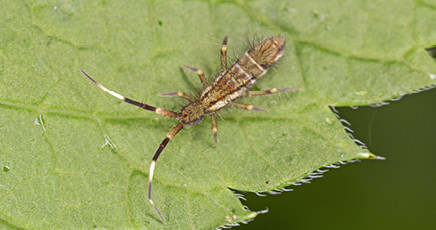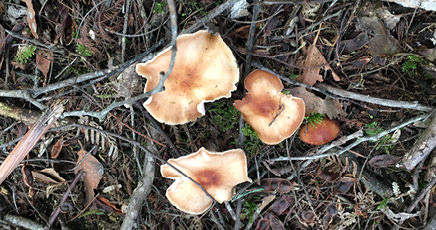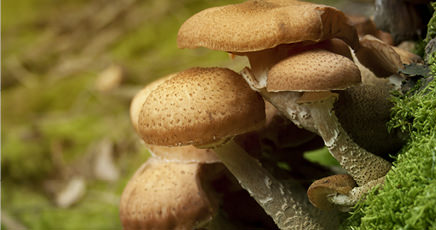STORY
Suyin’s Grandfather asked if she would help him with the farm over the school holidays. Suyin didn’t need to be asked twice! Suyin found going to the farm and getting her hands dirty a lot of fun. “Soil, Suyin darling, it’s more than just dirt”. She could already hear her Grandfather repeat one of his favourite phrases. What treasures will Suyin find on her visit this time? Suyin is helping her Grandfather in his garden, moving a pile of old mulch. Excitedly, she finds what looks like spider webs growing through the twigs. It is the mycelium of a fungus, recycling the organic material. She wanted to look more closely and take a photo, so she ran inside to grab her magnifying glass and mobile phone. Suyin would later ask her Grandfather about what mycelium is, and how fungi help to break down organic matter.

Soil is much more than just dirt. In this activity, our learners will be conducting an investigation to see which animals and other organisms are recycling nutrients in the garden.
These organisms make up the soil food web, which includes microscopic bacteria, fungi, minute creatures such as springtails, worms, pill-bugs and other creatures we see in leaf litter. This activity invites children to delve under the surface to look for the organisms in the soil and make connections to their role in recycling nutrients.
For children to:
- explore a sample of soil searching for living things
- identify elements of the soil food web
- understand that healthy soil relies on a diverse range of organisms to recycle nutrients
- use tools to magnify soil sample and identify living things.
Soil food webs are at their most obvious in warm, moist soil with a significant compost layer. This activity is best conducted during a wetter time of year. If it is hot where you live, this should be a morning activity because the organisms you are investigating may be damaged or dry out from too much exposure to heat.
Introduction
In every square metre of soil, there are millions of organisms. These organisms make up the soil food web. The soil food web recycles nutrients in the soil, making them available for plant growth. The concept of the soil food web may be very new to children and educators alike. This activity is designed to facilitate a hands-on exploration of some soil samples to find evidence of the soil food web.
Preparation of equipment and resources prior to beginning the learning activity will help to make it a success. Access to magnifiers is helpful because some of the organisms are quite small. If magnifying glasses are not available, using technology such as the camera on phones and tablets can be a good substitute and there are a number of apps that allow these cameras to be used in macro mode.
*Time allocation is dependent on site selection and travel time.
Checklist
Instructions
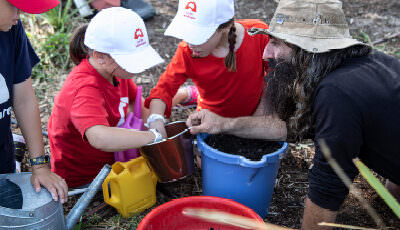
STEP 1
Identify a location for this investigation. Good locations to look for include under leaf litter, logs and in the mulch layer of the garden bed. Look for damp soil with plenty of organic material. (broken down leaf litter)
It is a good idea to collect a few samples first and set them aside to help with your explanation to the children later. Refer to the Educator’s Notes for some pointers on what to look for.
Assemble the materials you will need to conduct this investigation, including the digging/sampling tools and the resources you will need to view the soil samples.
We suggest establishing an area nearby your chosen location to use the magnification tools and complete the activity sheet.
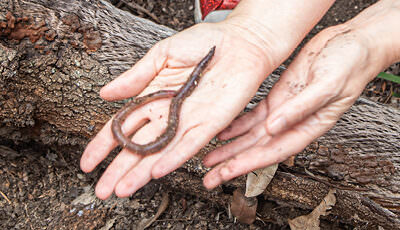
STEP 2
Before heading outside, discuss the idea of recycling. Focus on things that the children will be familiar with, such as recycling paper.
Explain that earth’s processes also recycle. Nutrients are recycled when organic material, such as leaves, bark and branches break-down.
A nutrient is a substance used by an organism to survive, grow, and reproduce.
In soil, nutrient recycling is performed underground by the soil food web. Take a moment to introduce the topic of the soil food web. Ask the children if they can describe what a worm does. Tell the children that the worm is part of the soil food web, but there are also other components too.
Use the soil food web diagram from the reference list below and show the children other elements of the food web and how they are linked together. (See the Educator’s Notes for more information).
Use online resources to research organisms that the children may encounter including:
- springtails
- nematodes
- the mycelial threads of fungi.
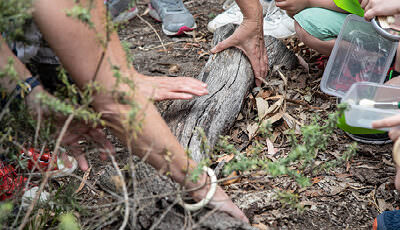
STEP 3
Head outside to the area that you have set-up for your investigation.
Outline safety aspects to the children, when conducting their observations.
- instruct how to use the garden trowels, spoons, paddle sticks or paintbrushes
- guide the children to tread lightly, taking care not to stand on anything living while exploring
- ask the children to return things back to how they found them, e.g. turned rocks or logs.
Ask the children to engage their senses during the investigation and take note of how the soil smells and feels as they sort through the organic layer.

STEP 4
Bring the samples to your investigation area.
Use the magnifiers or an app on a mobile phone or tablet to zoom-in on the samples.
Ask the children to explain what they see and what they wonder.
Use the activity sheet to draw what they see, and using the close-up inset circle to draw more detail as observed under magnification.
Return the samples back to where they were found.
Ask the children: what do they think we would find if we looked in the leaf litter again in:
- 3 days
- 3 weeks
- 3 months.
Extension Activity
Investigate the life-cycle of a springtail, drawing the stages of its life.
Become mycologists (fungi scientists) and grow your own mushrooms with a mushroom kit (these are commercially available).
Curriculum and Framework Links
SCIENCE
Year 2: ACSSU030, ACSHE035
Year 3: ACSSU044, ACSIS054
Year 4: ACSHE062, ACSIS064
Year 5: ACSHE083
Year 6: ACSSU094, ACSHE100
Year 7: ACSHE120
Year 8: ACSHE135
MATHEMATICS
Year 2: ACMMG044
Year 3: ACMMG065
Year 4: ACMMG090
Year 5: ACMMG109
Year 6: ACMMG137
Year 7: ACMMG159
Year 8: ACMMG196
HUMANITIES AND SOCIAL SCIENCES
Year 2: ACHASSI042
Year 3: ACHASSI052, ACHASSI059, ACHASSI060
Year 4: ACHASSI080, ACHASSK088, ACHASSK090
Year 5: ACHASSI102, ACHASSK120
Year 6: ACHASSI122, ACHASSI130
DESIGN AND TECHNOLOGIES
Year 2: ACTDEK003
Year 3 & 4: ACTDEP017
Year 5 & 6: ACTDEP019
Year 7 & 8: ACTDEK032
HEALTH AND PHYSICAL EDUCATION
Year 2: ACPPS018, ACPPS022, ACPPS023
Year 3 & 4: ACPPS036, ACPPS040, ACPPS041
Year 5 & 6: ACPPS054, ACPPS059
Year 7 & 8: ACPPS073, ACPPS078
ETHICAL UNDERSTANDING
Exploring values, rights and responsibilities
PERSONAL AND SOCIAL CAPABILITY
Social awareness
CURRICULUM CONNECTIONS
Outdoor Learning
CROSS CURRICULUM PRIORITY
Sustainability
MY TIME, OUR PLACE: FRAMEWORK FOR SCHOOL AGE CARE
Outcome 2 and 4
Reference List
READ
Leaf Litter, Exploring the Mysteries of a Hidden World, authored by Rachel Tonkin is a delightfully illustrated book with lift flaps that explores the hidden world of leaf litter.
ONLINE RESOURCES
Find out more about the soil food web on the Sustainable Gardening Australia Website.
Museum Victoria has developed a free National Field Guide app for Android and Apple devices. There are 8 apps available so choose one best suited to your location (NSW, ACT, VIC, SA, NT, QLD, WA & TAS).
Download the Urban Wildlife app for free to help you identify invertebrates.
Find out more about fungi with the Australian Association of Environmental Education Resource 1 and Resource 2.
Use this resource from the Riverina Environmental Education Centre to discover microorganisms.
PRINTABLE RESOURCES
The Australian Museum has a free Bugwise Invertebrate Guide to help your children identify common invertebrates from illustrations.
IMAGE ATTRIBUTION
Images by Landcare Australia and Adobe Stock
Image of group of nematodes from CSIRO, Photographer: EntomologyImage of Tasmanian fungi by Malu C. (2020 What’s in your backyard challenge Top 100)
We value your feedback
When you have finished this learning activity, please tell us what you think with our survey.
Your feedback will help Landcare Australia improve the activities in the Junior Landcare Learning Centre.
Why not try one of our other Junior Landcare learning activities?
Creating a butterfly garden
Biodiversity
Love Letters to the Land
Biodiversity|First Nations Perspectives|Food Production|Waste Management
Creating a sensory garden
Biodiversity
Understanding weeds: life cycle
Biodiversity
